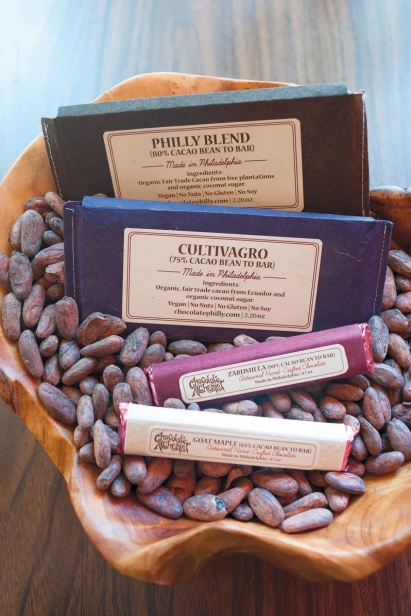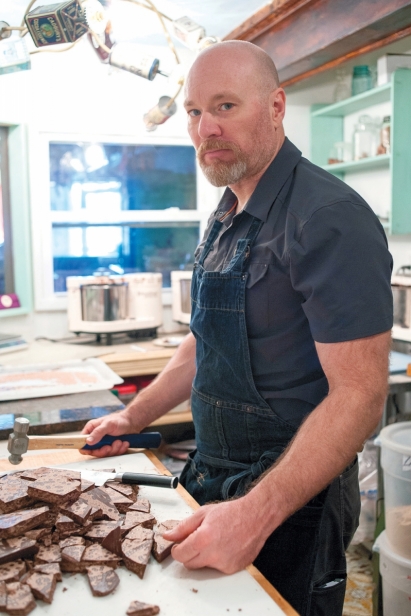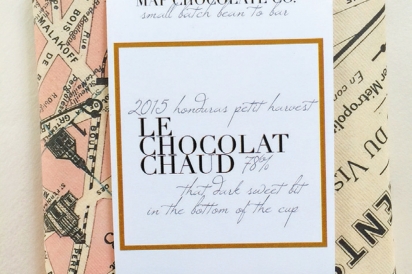Thirty-Seven Chocolates
My foray into the world of American craft chocolate
The words left my mouth on Halloween of 2013. “It does not feel like a birthday,” I lamented to my mom. She had flown from France to spend the next couple of months in Chester County with me, and her presence should have been reason enough to celebrate.
“Jonathan got you a cake, Estelle, and I’m here. What more do you want?”
Staring at the candy bowl from the living room couch, I pondered that question. She was right: I had everything I could possibly want. A roof over my head. A loving husband. A sweet daughter and a long-awaited, brand-new baby.
Yet I could not shake the feeling that something was missing. At 35, I was still looking for a purpose that neither my job nor my French food blog was providing anymore. On my next birthday, things would be different, I thought to myself. I would feel accomplished.
This impulse is something of a pattern with me. The following year, 2014, in an attempt to become more virtuous, I decided to perform 36 good deeds by my 36th birthday. Sadly, I did not get past three.
In March 2015, I resigned from a 10-year position in the corporate world. Up in Canada, my friend Nicole and her childhood friend committed to run a 50K race on their shared 50th birthday. The run received national coverage and the two friends crossed the finish line with the support of their family and friends. Now that was an accomplishment. Soon, Nicole was looking for a challenge for her 51st birthday.
“You worked hard,” I said. “Now it’s time to play hard! Why not eat 51 chocolates?”
She dismissed the idea. I thought it was awesome.
It was right before Memorial Day and, after publishing a food survival guide for French expats in the United States, I was looking for a new project. I had witnessed the rise of the US bean-to-bar chocolate movement—that is, bars made from scratch from actual cacao beans, instead of melted and remolded industrial chocolate. Curious to learn more, I gave the idea some consideration.
I loved chocolate. I had time. I needed a purpose.
“Fine, Nicole. I’ll do it.”
That was how, in June 2015, I committed to sampling 37 chocolate bars by my 37th birthday, that Halloween.
The First Bite
Before this challenge, the chocolate I ate came straight from the grocery store. For the past several years, I had resorted to chocolate to help me cope with my deadline-driven job. I would buy several bars on sale at the grocery store, but never spent more than $3.50 on chocolate. I ate chocolate for stress relief, and, yes, I ate it mindlessly.
I had been curious about the concept of bean-to-bar chocolate, but felt guilty at the idea of spending the equivalent of an hour of minimum wage on a three-ounce piece of indulgence. Besides, my first taste of an eight-dollar bar had made one thing clear: the term “bean-to-bar” is not a guarantee of quality. I had decided to stick with mass-produced, reliable and inexpensive bars.
After I left my job, I started wondering what awaited me outside of my chocolate comfort zone. Eating disappointing bars felt like going on bad dates. I wanted “the one,” so I took a leap of faith, grabbed my wallet and headed out to Philter Coffee in Kennett Square. Philter features a small selection of American craft chocolate. Waiting in line, I had many times picked a bar to study its wrapper, looking for a reason to splurge. On the front, next to an illustration, would be the name of a faraway country, along with a high cacao percentage. On the back, there was generally a short list of ingredients—typically cacao beans and cane sugar— and a batch number, stamped or written by hand. There were sometimes tasting notes that made me roll my eyes.
Hibiscus? Really?
It was the kind of scant information that left me with more questions than answers: What was so special about cacao from Trinidad? I would return the bar to its shelf before ordering a croissant with my latte. The only way to explore the world of craft chocolate, it seemed, was to eat my way through a lot of it. To kick-start the challenge, I chose a half-ounce bar of Twenty-Four Blackbirds Chocolate. Handcrafted in California, the single-origin bar stood out for its light color, subtle citrus notes and complete lack of bitterness—all of which, I would later learn, are noted characteristics of Madagascar cacao beans. This did not taste like my typical dark chocolate at all. I was confused: Did I actually like it?
At home, I jotted my impressions in a small notebook. When I announced my challenge on Instagram, I realized I wanted to share more than tasting notes, and video seemed like a better medium. A quick YouTube search only revealed a handful of bean-to-bar chocolate reviews. I knew what that meant: Sooner or later, my voice would be heard. I had five months and 37 bars to make it matter.
With more than a hundred bean-to-bar chocolate makers operating in the United States, a few orders from chocolate sites could easily have provided enough material for my challenge. However, chocolate felt like such a mysterious food—it relies on a crop you can’t find in a grocery store and requires equipment you can’t pick up in a kitchen shop—that I craved a physical connection with each bar.
I hunted down chocolate at local coffee shops and independent food stores. Who knew that Carlino’s, an Italian-inspired gourmet shop in West Chester, carried so many bars? I accepted my friend Teresa’s offer to bring me bars from Atlanta. Laura, a chocolate-loving barista at Philter, recommended two dark milk chocolates, which I spotted at Gryphon Coffee in Wayne: Nathan Miller’s 55% Buttermilk Chocolate and my very fi rst craft-chocolate crush, the boldly flavored, slightly crunchy 65% Milk & Nibs bar by Acalli. By early July, I had gathered a large enough stash to last through the end of the summer.
The Many Flavors of Chocolate
Bar by bar, I was discovering the complex world of chocolate through the lens of American craft makers. It soon became evident that not all cacaos or bars were created equal, and that chocolate was not one single fl avor but a myriad. I began to understand why so many people compared chocolate to wine. I was so glad I hadn’t let one bad bar stop me from exploring this hidden world. Cacao, it seemed, was a magical food. I became grateful for the bean-to-bar makers who made us appreciate its power. With its acidity and long, spicy fi nish, a bar that Potomac Chocolate had crafted from Venezuelan Cuyagua cacao filled me with awe.
One bar forever sealed my love for craft chocolate. At Cacao Atlanta, my friend Teresa had asked the store employee for “something special” to bring me back as a present. Made of beans from Patanemo, Venezuela, it had a cherry finish so intense it took my breath away. It was, as I said in my review, “a black-forest cake in bar form.”
Looking to deepen my connection with chocolate, I scouted Instagram every evening looking for new bars to try. While I patted my youngest daughter to sleep, I used the hashtag #beantobar to tell makers about my challenge. David Menkes, cofounder of LetterPress Chocolate in Los Angeles, recommended some brands and opened my eyes to the issue of sustainable cacao farming. After I placed an order in September, he surprised me by customizing a wrapper for my challenge.
I loved the thrill of spotting a new maker—like Violet Sky Chocolate in Indiana, whose beautiful name and vanilla-dusted bars sparked my curiosity. The company had no online shop. When I emailed founder Hans Westerink to ask for help in my chocolate selection, he explained that the seasonality of his bars was inspired by the same part of nature that gives the company its name. “Beautiful skies don’t last long and will always be different, so we try to enjoy each moment as much as possible,” he wrote. Swoon.
Also on Instagram, I discovered Map Chocolate, an Oregon-based maker whose shiny chocolate bars stood out, thanks to their square shape and intricate design, reminiscent of Moroccan tiles. Its product descriptions read like chapters of a novel. The founder, Mackenzie Rivers, gave her bars intriguing names, like “Dear Mr. Finley,” which, she wrote, tasted of “birdsong,” and Le Chocolat Chaud, a 78% dark chocolate made of beans that “arrived as a half-full jute sack, the remainder of which had, evidently, been lost in transit.” Her work, which combined my love for the written word and my budding passion for chocolate, moved me to tears. I would feature her bars, I decided, at the end of the challenge. To this day, Map Chocolate remains one of my favorite American chocolate-makers.
In my video reviews, I made a point to share the information I had once been looking for on chocolate wrappers. I commented on the texture of chocolate—some chocolates were quite gritty—and shared a story about the maker. I described flavors in general terms, such as floral or fruity, and commented on the balance of flavor and the length of a finish instead of highlighting a specific flavor. Above all, I wanted the reviews to be approachable and fun, so halfway through the challenge, I reviewed the chocolate all addicts keep in their stash—the beloved chocolate chip.
Bean-to-Bar Chocolate in Philadelphia
In early fall, my not-so-secret wish to meet a chocolate maker was granted when an Instagram user named @chocolatealchemist informed me he was “Philly’s only bean-to-bar chocolate maker.” His profile listed several enticing creations: bars, truffles, “world-class drinking chocolate” and “vegan confections that don’t suck.”
In mid-October I met the actual Chocolate Alchemist, Robert Campbell, at Sazon, the Northern Liberties Venezuelan restaurant he co-owns, where he runs his small-batch chocolate operations. After greeting me with a kiss on the cheek—a habit he picked up in Venezuela—he explained how his background as an endurance athlete has influenced his creations. Cacao, he said, is a nutritional powerhouse, and chocolate is a vehicle for energy. While most makers swear by single-origin cacaos, Campbell prefers blends, and while cane sugar is the traditional sweetener, he only uses unrefined sugars.
My chocolate tasting with Campbell started with bars hidden in hand-stitched, reusable wrappers. My favorites included the Clasico, a 60% dark milk chocolate with hazelnut and coconut, and the Philly Blend, an 80% dark chocolate made of five cacaos. They were assertive but balanced, a reflection of Campbell’s personality.
Campbell’s drinking chocolates, made from cacao beans, are true show-stoppers. I fell hard for the Calabaza, a thick, boldly flavored chocolate flavored with pumpkin and nutmeg and garnished with pecans and pumpkin seeds that I polished off with a spoon. The Clasico, his version of a dark milk chocolate, boasted an intense, slightly acidic cacao flavor that cut through the dairy. The drink was at once nourishing and satisfying, rich but not heavy. It was, hands down, the best drinking chocolate I have had in the United States. Hours later, he sent me home with a small bag of cacao beans, four chocolate bars, a newfound appreciation of chocolate and my first chocolate high.
Before leaving, he asked about my plans after Halloween. “You’re going to stay in chocolate, right?” I nodded. He smiled. On October 31, 2015, I woke up lighthearted: My 37th review had just gone live, so my challenge was officially over. My journey had revealed as much about me as it had about chocolate. My attempts to map that world had rewarded me with an unexpected gift—a brand-new passion I wanted to continue sharing. Smiling at the Clasico mustache on my daughter’s face that day, I finally felt truly accomplished.
ACALLI CHOCOLATE
NEW ORLEANS, LOUISIANA
65% Dark Milk Chocolate with Nibs
acallichocolate.com
CACAO ATLANTA
ATLANTA, GEORGIA
Patanemo, 75% Dark Chocolate
cacaoatlanta.com
CHOCOLATE ALCHEMIST
PHILADELPHIA, PENNSYLVANIA
Clasico, 60% Dark Milk Chocolate with Coconut and Hazelnut Philly Blend, 80% Dark Chocolate
sazonphilly.com/chocolates
CHUAO CHOCOLATIER
SAN DIEGO, CALIFORNIA
Firecracker (includes popping candy), Salted Chocolate Crunch
chuaochocolatier.com
Note: Chuao is not a bean-to-bar company, but the bars are made in the United States.
DANDELION CHOCOLATE
SAN FRANCISCO, CALIFORNIA
Mantuano, Venezuela, 70% Dark Chocolate San Francisco de Macorís, Dominican Republic, 70% Dark Chocolate Ambanja, Madagascar, 70% Dark Chocolate
dandelionchocolate.com
DICK TAYLOR CRAFT CHOCOLATE
EUREKA, CALIFORNIA
Belize, 72% Dark Chocolate Black Fig, 72% Dark Chocolate
dicktaylorchocolate.com
ENDANGERED SPECIES CHOCOLATE
INDIANAPOLIS, INDIANA
72% Dark Chocolate with Blueberries
chocolatebar.com
GHIRARDELLI
SAN FRANCISCO, CALIFORNIA
Midnight Dream, 60% Dark Chocolate
ghirardelli.com
GUITTARD CHOCOLATE COMPANY
BURLINGAME, CALIFORNIA
Chocolate Chips, 55% Cacao
guittard.com
LETTERPRESS CHOCOLATE
LOS ANGELES, CALIFORNIA
Marañon Bar, 70% Dark Chocolate Ucayali Bar, 70% Dark Chocolate
letterpresschocolate.com
MAP CHOCOLATE CO.
EUGENE, OREGON
Dear Mr. Finley, 68% Dark Chocolate Le Chocolat Chaud, 78% Dark Chocolate
mapchocolate.com
MAST BROTHERS
BROOKLYN, NEW YORK
Brooklyn Blend, 70% Dark Chocolate Cow Milk, Goat Milk Chocolate
mastbrothers.com
NATHAN MILLER CHOCOLATE
CHAMBERSBURG, PENNSYLVANIA
Buttermilk 55% Dark Chocolate
nathanmiller.myshopify.com
OLIVE AND SINCLAIR CHOCOLATE
NASHVILLE, TENNESSEE
75% Dark Chocolate
oliveandsinclair.com
POTOMAC CHOCOLATE
WOODBRIDGE, VIRGINIA
Cuyagua, 70% Dark Chocolate
potomacchocolate.com
SCHARFFEN BERGER
SAN FRANCISCO, CALIFORNIA
70% Bittersweet Dark Chocolate, 72% Pistachio Dark Chocolate
scharffenberger.com
TAZA CHOCOLATE
SOMMERSVILLE, MASSACHUSETTS
Cinnamon Disc, 50% Dark Chocolate Vanilla Disc, 50% Dark Chocolate
tazachocolate.com
TCHO
BERKELEY, CALIFORNIA
70% Ghana Chocolate, 53% Milk Chocolate Mokaccino, 39% Milk Chocolate
tcho.com
THEO CHOCOLATE
SEATTLE, WASHINGTON
Salted Almond, 70% Dark Chocolate
theochocolate.com
TWENTY-FOUR BLACKBIRDS CHOCOLATES
SAN FRANCISCO, CALIFORNIA
Madagascar, 75% Dark Chocolate
twentyfourblackbirds.com
VIOLET SKY
SOUTH BEND, INDIANA
Banana Split, White Chocolate Belize, 77% Dark Chocolate with Candied Lavender & Vanilla Dust
violetskychocolate.com
WOODBLOCK CHOCOLATE
PORTLAND, OREGON
60% Dark Milk Chocolate Sea Salt and Nibs, 70% Dark Chocolate
woodblock.myshopify.com









